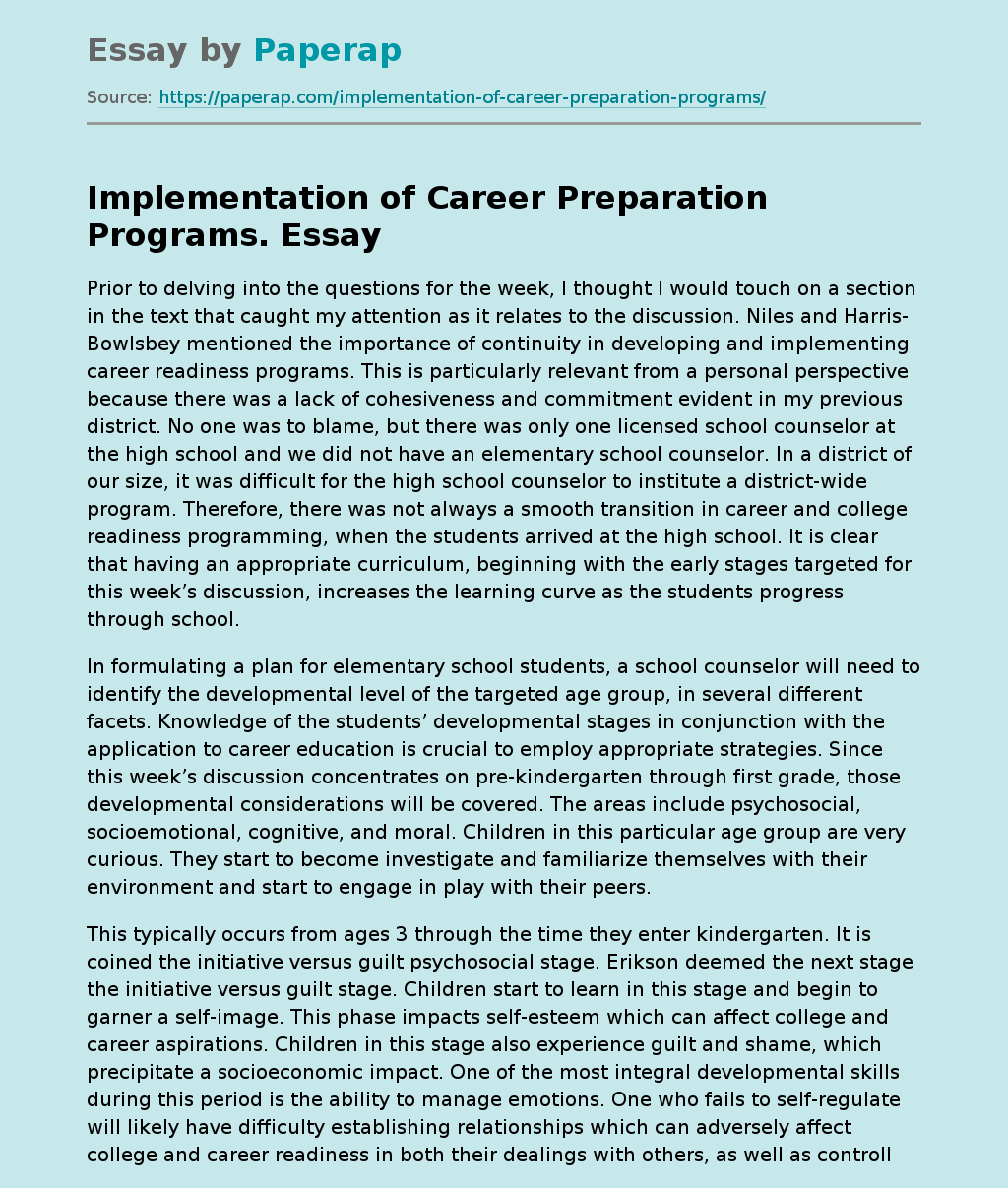Implementation of Career Preparation Programs.
Prior to delving into the questions for the week, I thought I would touch on a section in the text that caught my attention as it relates to the discussion. Niles and Harris-Bowlsbey mentioned the importance of continuity in developing and implementing career readiness programs. This is particularly relevant from a personal perspective because there was a lack of cohesiveness and commitment evident in my previous district. No one was to blame, but there was only one licensed school counselor at the high school and we did not have an elementary school counselor.
In a district of our size, it was difficult for the high school counselor to institute a district-wide program. Therefore, there was not always a smooth transition in career and college readiness programming, when the students arrived at the high school. It is clear that having an appropriate curriculum, beginning with the early stages targeted for this week’s discussion, increases the learning curve as the students progress through school.
In formulating a plan for elementary school students, a school counselor will need to identify the developmental level of the targeted age group, in several different facets. Knowledge of the students’ developmental stages in conjunction with the application to career education is crucial to employ appropriate strategies. Since this week’s discussion concentrates on pre-kindergarten through first grade, those developmental considerations will be covered. The areas include psychosocial, socioemotional, cognitive, and moral. Children in this particular age group are very curious. They start to become investigate and familiarize themselves with their environment and start to engage in play with their peers.
This typically occurs from ages 3 through the time they enter kindergarten. It is coined the initiative versus guilt psychosocial stage. Erikson deemed the next stage the initiative versus guilt stage. Children start to learn in this stage and begin to garner a self-image. This phase impacts self-esteem which can affect college and career aspirations. Children in this stage also experience guilt and shame, which precipitate a socioeconomic impact. One of the most integral developmental skills during this period is the ability to manage emotions. One who fails to self-regulate will likely have difficulty establishing relationships which can adversely affect college and career readiness in both their dealings with others, as well as controlling their own emotions.
Cognitive skills also begin to expand during this time. Children begin an initial phase of understanding time in regards to past and present. Though they are still not able to fully grasp the concept of the future. They are also more creative and evolve into more elaborate play. Because students are in the preoperational phase of learning, it is important to teach them incrementally. I equate it to trying to teach young children any skill, such as a sport. The more it is broken down, the easier it becomes for them to imitate the final product. Similarly, this would include teaching and addressing the same information or skill over and over to accommodate their learning ability. Moral development at this age group is the time when children begin to differentiate between right and wrong. Positive reactions or responses tend to associate with what the child perceives as right and conversely, negative reactions or responses they deem as wrong. Their perception of right or wrong may include how they begin to view certain careers or certain colleges or education in general.
Gender also plays a role in career and college readiness and is discussed by Gottfredson. In her Theory of Circumscription and Compromise, one of her focuses at this stage of a child’s development is Orientation to Sex Roles. Children begin to rule out certain careers based on their association with the opposite gender. It is essentially sexual stereotyping in relation to careers. For instance, young boys who associate nurses as female or young girls who believe police officers are male. In addition, she notes the Orientation to Size and Power, which is equates his or her current lack of size or strength to his or her inability to perform that task and ruling it out as a career option. School counselors can incorporate exposure and help broaden career choices by reducing these stigmas.
Considering the stages of development and theories relating to this age group, my preferred technique for college and career readiness would be through the use of play. I recently took a play therapy course and was more engrained in the content than I had planned since I currently work with high school students. Dr. Garry Landreth (2012, p. 7) noted, “Unlike adults, whose natural medium of communication is verbalization, the natural medium for children is play and activity.” Play can be used in a variety of ways to assist with careers. One of my plans would be to have toys categorized in the various career clusters and allow the students to play freely with those toys while reviewing some information about the different careers. Another option would be to have a career day and allow the students to dress up or bring in toys relating to a career of interest. Obviously, earlier lessons would have to be planned to increase awareness of various careers and some dress code regulations would need to be put in place.
Implementation of Career Preparation Programs.. (2021, Dec 10). Retrieved from https://paperap.com/implementation-of-career-preparation-programs/

